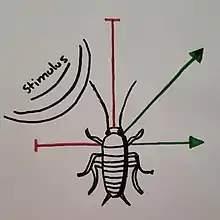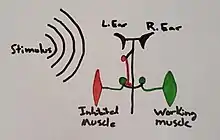Escape reflex
Escape reflex, or escape behavior, is any kind of escape response found in an animal when it is presented with an unwanted stimulus.[1] It is a simple reflectory reaction in response to stimuli indicative of danger, that initiates an escape motion of an animal. The escape response has been found to be processed in the telencephalon.[2]

Escape reflexes control the seemingly chaotic motion of a cockroach running out from under a foot when one tries to squash it.

In higher animals, examples of escape reflex include the withdrawal reflex (e.g. the withdrawal of a hand) in response to a pain stimulus. Sensory receptors in the stimulated body part send signals to the spinal cord along a sensory neuron. Within the spine, a reflex arc switches the signals straight back to the muscles of the arm (effectors) via an intermediate neuron (interneuron) and then a motor neuron; the muscle contracts. There often is an opposite response of the opposite limb. Because this occurs automatically and independently in the spinal cord, the brain only becomes aware of the response after it has taken place.
Crossed extensor reflex
The crossed extensor reflex is another escape reflex, but it's a type of withdrawal reflex.[5] It is a contralateral reflex that allows for the affected limb to have the flexor muscles contract and the extensor muscles to relax while the unaffected limb has the flexor muscles relax and the extensor muscles to contract.[5] For example, stepping on a piece of glass causes the affected leg to be lifted or withdrawn and the unaffected leg to carry the additional burden of weight and maintain postural support.[6] In this example, the afferent nerve fibers are stimulated on the right foot. The nerve fibers travel up to the spinal cord where they cross the midline, go to the left side, and synapse on an interneuron. When the afferent nerve fibers synapse on the interneuron, they can either inhibit or excite an alpha motor neuron on the muscles on side contralateral to the stimulus.[5]
Escape reflex arcs
Escape reflex arcs have a high survival value enabling organisms to take rapid action to avoid potential danger or physical damage. The effectiveness of escape reflexes can be lowered when an organism is experiencing high levels of fatigue and or stress.[7] These factors cause delays or weakness in the reflex, and they can even develop into learned helplessness, which has been found in animals and Drosophila flies.[8] The reflex can also be habituated as seen in the tail-flip escape reflex of crayfish.[9] More recent studies have also indicated that, once this crayfish escape response is habituated, it can also be recovered.[10] A similar long-term habituation of the C-start escape response has also been studied in the larvae of zebrafish.[11]
Various animals may have specialized escape reflex arcs.
Examples
- Withdrawal reflexes
- Ducking (flexing the neck to protect the head)
- Jumping at loud sounds
- Withdrawal of a body part when it touches something (e.g., excessively hot or cold)
- Other
- Lateral giant escape[12] and tail-flip reflex[13] in crayfish
- Escape reflex in squid[14]
- Dorsal ramp interneuron (DRI) action in Tritonia mollusks[15][16]
- C-start in fish and amphibia[17]
- Escape reflex in earthworms[18]
See also
References
- "APA Dictionary of Psychology". dictionary.apa.org. Retrieved 2020-01-31.
- Schwarze S, Bleckmann H, Schluessel V (October 2013). "Avoidance conditioning in bamboo sharks (Chiloscyllium griseum and C. punctatum): behavioral and neuroanatomical aspects". Journal of Comparative Physiology. A, Neuroethology, Sensory, Neural, and Behavioral Physiology. 199 (10): 843–56. doi:10.1007/s00359-013-0847-1. PMID 23958858.
- Booth, D.; Marie, B.; Domenici, P.; Blagburn, J. M.; Bacon, J. P. (2009-06-03). "Transcriptional Control of Behavior: Engrailed Knock-Out Changes Cockroach Escape Trajectories". Journal of Neuroscience. 29 (22): 7181–7190. doi:10.1523/JNEUROSCI.1374-09.2009. ISSN 0270-6474. PMC 2744400. PMID 19494140.
- Catania, Kenneth C. (April 2011). "The brain and behavior of the tentacled snake". Annals of the New York Academy of Sciences. 1225 (1): 83–89. doi:10.1111/j.1749-6632.2011.05959.x. ISSN 0077-8923. PMID 21534995.
- "Reflexes". Boundless Anatomy and Physiology. courses.lumenlearning.com. Retrieved 2020-04-27.
- Purves D, Augustine GJ, Fitzpatrick D, Katz LC, LaMantia AS, McNamara JO, Williams SM (2001). "Flexion Reflex Pathways". Neuroscience (2nd ed.). Sunderland (MA): Sinauer Associates.
- King CD, Devine DP, Vierck CJ, Rodgers J, Yezierski RP (October 2003). "Differential effects of stress on escape and reflex responses to nociceptive thermal stimuli in the rat". Brain Research. 987 (2): 214–22. doi:10.1016/S0006-8993(03)03339-0. PMID 14499966.
- Batsching S, Wolf R, Heisenberg M (2016-11-22). "Inescapable Stress Changes Walking Behavior in Flies - Learned Helplessness Revisited". PLOS ONE. 11 (11): e0167066. doi:10.1371/journal.pone.0167066. PMC 5119826. PMID 27875580.
- Krasne FB, Teshiba TM (April 1995). "Habituation of an invertebrate escape reflex due to modulation by higher centers rather than local events". Proceedings of the National Academy of Sciences of the United States of America. 92 (8): 3362–6. doi:10.1073/pnas.92.8.3362. PMC 42166. PMID 7724567.
- Stahlman WD, Chan AA, Blumstein DT, Fast CD, Blaisdell AP (September 2011). "Auditory stimulation dishabituates anti-predator escape behavior in hermit crabs (Coenobita clypeatus)". Behavioural Processes. 88 (1): 7–11. doi:10.1016/j.beproc.2011.06.009. PMID 21756986.
- Roberts, Adam C.; Pearce, Kaycey C.; Choe, Ronny C.; Alzagatiti, Joseph B.; Yeung, Anthony K.; Bill, Brent R.; Glanzman, David L. (October 2016). "Long-term habituation of the C-start escape response in zebrafish larvae". Neurobiology of Learning and Memory. 134: 360–368. doi:10.1016/j.nlm.2016.08.014. PMC 5031492. PMID 27555232.
- Krasne FB (February 1969). "Excitation and habituation of the crayfish escape reflex: the depolarizing response in lateral giant fibres of the isolated abdomen". The Journal of Experimental Biology. 50 (1): 29–46. PMID 4304852.
- Krasne FB, Shamsian A, Kulkarni R (January 1997). "Altered excitability of the crayfish lateral giant escape reflex during agonistic encounters". The Journal of Neuroscience. 17 (2): 709–16. doi:10.1523/JNEUROSCI.17-02-00709.1997. PMC 6573235. PMID 8987792.
- Otis, T. S.; Gilly, W. F. (1990-04-01). "Jet-propelled escape in the squid Loligo opalescens: concerted control by giant and non-giant motor axon pathways". Proceedings of the National Academy of Sciences. 87 (8): 2911–2915. doi:10.1073/pnas.87.8.2911. ISSN 0027-8424. PMC 53803. PMID 2326255.
- Frost, W. N.; Hoppe, T. A.; Wang, J.; Tian, L.-M. (August 2001). "Swim Initiation Neurons in Tritonia diomedea". American Zoologist. 41 (4): 952–961. doi:10.1093/icb/41.4.952. ISSN 0003-1569.
- Frost, W. N.; Katz, P. S. (1996-01-09). "Single neuron control over a complex motor program". Proceedings of the National Academy of Sciences. 93 (1): 422–426. doi:10.1073/pnas.93.1.422. ISSN 0027-8424. PMC 40250. PMID 8552652.
- Eaton RC, Lee RK, Foreman MB (March 2001). "The Mauthner cell and other identified neurons of the brainstem escape network of fish". Progress in Neurobiology. 63 (4): 467–85. doi:10.1016/s0301-0082(00)00047-2. PMID 11163687.
- Drewes CD, Vining EP, Zoran MJ (1988-11-01). "Regeneration of Rapid Escape Reflex Pathways in Earthworms". Integrative and Comparative Biology. 28 (4): 1077–1089. doi:10.1093/icb/28.4.1077.